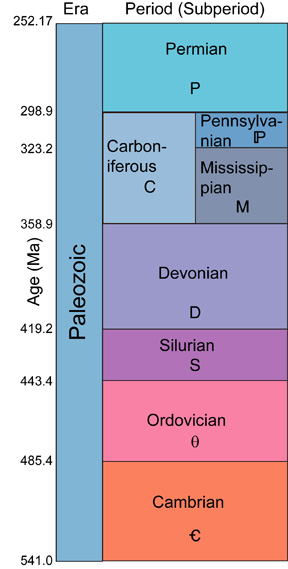GEOL 102 Historical Geology
Spring Semester 2011
The Late Paleozoic Era I: Carboniferous Geology

Phanerozoic Eon: 542 - 0 Ma
Paleozoic Era: 542 - 252.3 Ma
| Period | Range (Ma)
|
|---|
| Permian | 299 - 252.3
|
| Carboniferous | 359 - 299
|
| OR Pennsylvanian | 318 - 299
|
| & Mississippian | 359 - 318
|
In traditional non-North American geology the (North American) Mississipian and Pennsylvanian Periods were not recognized;
the Mississippian Period is thus the same
as the traditional European Early Carboniferous Epoch and the Pennsylvanian Period is equivalent to the traditional European Late
Carboniferous Epoch. In the latest international time scale, a compromise was reached, and the Mississippian and Pennsylvanian are
"sub-periods" of the Carboniferous (each has three Epochs).
Paleogeography and Geology of the
Mississippian:
Tabulate-stromatoporoid reefs disappear; related to switch from calcite seas to
aragonite seas:
- When midocean ridges have low activity, high levels of Mg relative to Ca:
aragonite seas with reduced reef building activity
- When midocean ridges have high activity, low Mg/Ca ratios: calcite seas with
increased reef building activity
- Early Cambrian through mid-Mississippian, calcite seas
- mid-Mississippian through mid Jurassic, aragonite seas
- mid-Jurassic through mid-Cenozoic, calcite seas
- mid-Cenozoic through today, aragonite seas
During Mississippian, no reef complexes of significance.
Huge carbonate banks in most shallow seas: crinoid meadows produce limestones whose
main clasts are crinoid columnal elements.
Continued decline of CO2 -- sucked up into soils, and eventually coals -- lowers greenhouse effect, start of new
series of Gondwanan glaciations. Non-reduced oxygen accumulates in the atmosphere.
During Late Mississippian, the
Variscan Orogeny:
- Beginning of the collision between the Iberian & Armorican parts of Gondwana and Euramerica,
and thus the loss of most of the Rheic Ocean and well on the way to the assembly of Pangaea
- Once the "Hercynian" Orogeny was considered a separate event, but this seems to be part of the same complex
End of Mississippian: major regression, associated with mass extinction of some groups
of stalked echinoderms and ammonoids.
Paleogeography and Geology of the
Pennsylvanian:
Continued decline of CO2 (to just about modern levels!). O2 levels reach their maximum
in Earth history (around or above 30%). Since N2 levels (which represent the majority of the atmosphere) would
have likely remained constant, total atmospheric density reaches its highest in the age of blue skies (i.e., since the
reducing atmosphere was oxidized).
As a consequence of this, forest fires become EXTREMELY easy to trigger. Also, higher O2 levels may have
been the reason that very large terrestrial arthropods could live in the Carboniferous.
Continued glaciation in Gondwana: southern continents remain largely emergent.
Continued Collision of Gondwana and Euramerica:
- Eastern Laurentia-Gondwana (Africa) collision closes Rheic Ocean producing
Alleghanian Orogeny (late Mississippian-Pennsylvanian):
- The third and last part of the Appalachian Orogeny
- Resultant mountain range was at least as high as present Himalayas!
- Southern Laurentia-Gondwana (Florida, South America, etc.) collision called
Ouachitan Orogeny
(Late Pennsylvanian):
- Deformed large sequence of deep marine passive margin sediments accumulating from
Ordovician through Early Pennsylvanian
- Assembly of Laurussia and Gondwana produces most of Pangaea:
- Only Siberia (which collides with Euramerica to form the Uralian Orogeny in the Pennsylvannian and Permian) and other Asian cratons (which collide
in late Permian through Triassic) remain separate continents
- Creation of the Tethys Ocean (a large embayment on the eastern seaboard of
Pangaea, with its own typical warm-water fauna)
Alleghanian Orogeny produced the direct "ancestor" of the modern Appalachians: the
current mountains are the erosional remnants of the fold-and-thrust belt of the
Alleghanian Appalachians.
Unusual cratonic deformation in southwestern Laurentia:
- Formation of the
Ancestral Rockies (the Front Range and Umcompahgre uplifts)
- Orogeny not by collisional events per se, but by vertical faulting and uplift
- Uplift may be response to stresses generated by Ouachita orogeny
- Produced huge amount of sediment, deposited nearby throughout southwest
MOST IMPORTANT GEOLOGICAL EVENT OF PENNSYLVANIAN:
- Cyclothems
(called "Coal Measures" in Europe)
- Repetitive sequences of transgressions-regressions of nearshore and paludal deposits
- Cover large expanses of North America, Europe, Russia, China: not common in Gondwana
- Contain vast majority of Earth's coal deposits
- Huge amounts of buried vegetation removed vast amounts of CO2 from Earth's atmosphere:
these levels have NEVER returned to pre-Mississippian levels, although did rise again
during Late Permian
- The Industrial Revolution ran on Pennsylvanian deposits; the threat of anthropogenic
global warming is that we will liberate enough CO2 to reach mid-Paleozoic levels!
- Coal in great deposists may be helped in Carboniferous for multiple reasons"
- Physical geology and glacioeustacy (see below)
- High level of atmospheric oxygen may promote charcoalification (pre-burial burning); some experimental evidence
suggests that much coal is actually charcoalified rather than simply buried
- May have been early enough in history that major tree-decomposing bacteria and fungi had not yet evolved, hence
more debris to be buried
Formation of cyclothems
- Northern continents were very low relief during Pennsylvanian
- Extensive coal swamps covered the coastlines
- As Gondwanan glaciers expanded, regressions and swamps moved seaward
- As Gondwana glaciers retreated, transgressions and swamps moved landward
- Repetitions could be VERY rapid (few tens of thousands of years)
- Evidence from charcoal among the coal suggests that some represent huge, high temperature
forest fires (not unlikely, given higher O2 levels during Pennsylvanian)
Some minor reefs formed by sponges, bryozoans, and algae.
To Next Lecture.
To Previous Lecture.
To Syllabus.
Last modified: 14 January 2011


